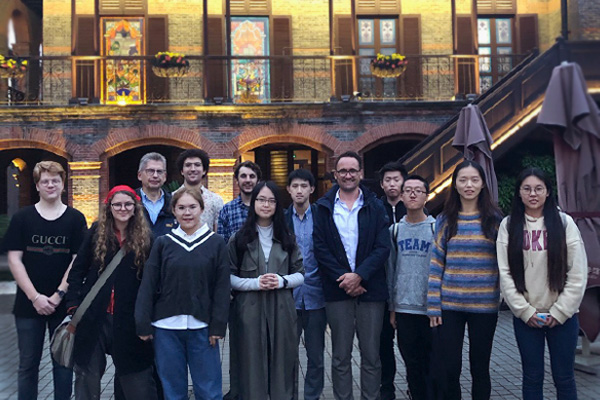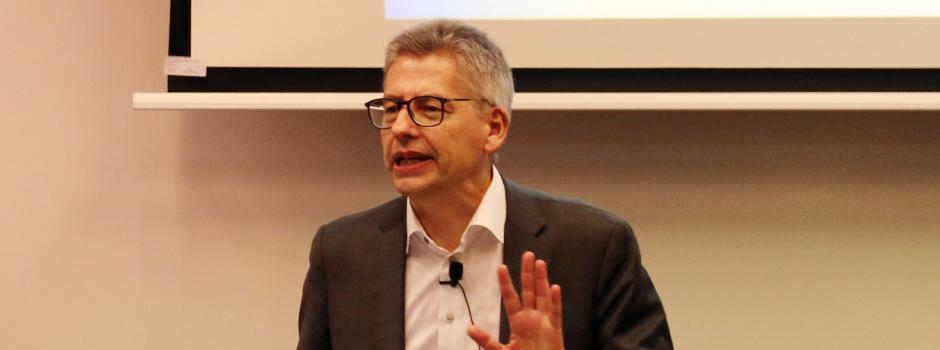The world is aging. According to the United Nations, the number of people aged 60 years or older will double by the year 2050, and triple by 2100. The population aged 60 or over is growing faster than all younger age groups. This will have tremendous implications for aspects of society - labor, housing, transportation, social protection, and family structures.

Last week, Professor Alexander Geppert invited Christoph Conrad, a history professor from the University of Geneva who has traced the historical origins of the global aging crisis, to visit with students from his class War and Peace: Europe Since 1900. Conrad also shared his research in an open talk on Nov 8 with the greater NYU Shanghai Community. Yang Ziqi ‘21, a student in Geppert’s class, took the opportunity to conduct a one-on-one interview with Prof. Conrad around this topic:
Q: How did you build your research interest in the history of human aging? What kinds of topics interest you?
My PhD thesis was about the history of old age in Germany from 1830 to 1930, it was a classical monograph in social history with a mix of approaches from demography, history of medicine, and studies of welfare state development. While studying and researching abroad (in France, Britain, and the US), I became interested in comparative methods and published some studies on social policies and intergenerational equity in an international perspective.
My current interest in “global aging” is a kind of return to my roots but also a very new experience since it involves analyzing material from other parts of the world. While I am interested in analyzing the hard data about the demography and socio-economic consequences of aging I am more and more interested in world views, expert discourses, and images of old age. Such images frame our visions of the future and prevent many decision makers from fully grasping the potential of aging societies.
Q: How do you suggest we look into the issue of aging from a global perspective? By global, do you mean, aging society has become a common concern that binds the international community, or require nation states to think of solutions?
“Global aging” is global in at least three senses. The demographic changes are first the object of a global discourse that is held by experts, planners, journalists, and politicians on an international level. The United Nations and their specialized organizations (for population, health, or work) as well as the OECD and World Bank have played a decisive role in this respect. Second, the wave of aging is ‘global’ since its causes (decline of fertility and rising life expectancy) actually concern nearly every country in the world – with highly diverse timing, scale, and impact of course. Third, and that is your question, we can ask whether the political – but also scientific, technological or financial – reactions to the greying of the planet are equally ‘global’ or rather national.
Since social security, family and health policies are largely national responsibilities one would assume that they are the first instances to react to a population aging. However, many factors that have accelerated the demographic changes (like birth control, vaccinations, fight against epidemics, general development policies) are part of international exchanges and global circulation. This is also true for cultural visions of the ideal family or intergenerational relations.
Q: In what ways has aging changed the world? How is it changing family structures in Europe, Asia or other parts of the world? What could be the impact?
This is not easy to answer since family structures in different parts of the world and even in different regions of one continent differ considerably. But what can be said is that the lowering of infant mortality and the higher longevity in adult and old ages have made family life more secure and predictable, have lengthened the overlap of generations and, this is very common in Europe for example, have multiplied the number of families with three or four generations.
But few of these families live together under the same roof. Individualism, economic necessities, limited housing, and migration are fostering small, “nuclear” households as well as growing numbers of people living alone. At the same time, radical fertility decline like in China our South Korea, leads to kinship structures in which very few members of the youngest generation are facing a majority of grandparents. This is practically an age pyramid upside-down, a phenomenon never seen in human history before.
Q: Traditionally, we rely on social institutions and social norms to provide caregiving for the aging population. However, in the booming aging industry, we also see innovative business models emerging every day in many parts of the world. How do you comment on this transformation?
In many parts of the world, the private sector has already for a long time participated in social protection and health care for the elderly as for other groups in society. Private pension funds, health and life insurance, for profit providers of care, hospitals and old age homes have long historical roots. What changes with the emergence of a sizeable percentage of elderly people in the population is their status as active and respected consumers. Their demands and their buying power encourage many developments like, for example, technological improvements of communication or mobility, more adequate household appliances, medical devices or the internet of things.
All this is market driven and extremely dynamic. Why should only the young be in the center of commercial attention? What worries me are tendencies of increasing social inequality or even exclusion among those who cannot afford to benefit from such innovations. As always in matters of public-private-mix, sound regulation and attention to unintended consequences are crucial.



